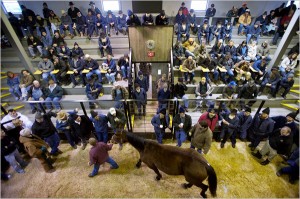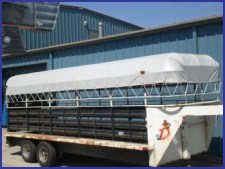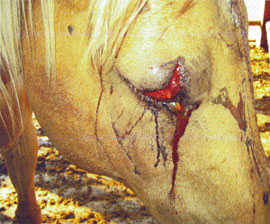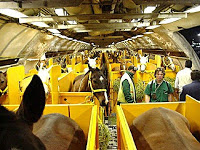Slaughter (Trucking and Road Transportation)
To begin, horses arrive at an auction sight where various buyers bid them on. Many horse owners take their horses to auction in hopes they will find a good home but that is not often the case. Many of these horses are purchased by middlemen hoping to sell the horses to slaughterhouses they’re what people call “killer buyers”. These buyers look for horses that will attract high prices at the slaughterhouses and will outbid other buyers who may be interested in purchasing the horses for recreational and family use.
good home but that is not often the case. Many of these horses are purchased by middlemen hoping to sell the horses to slaughterhouses they’re what people call “killer buyers”. These buyers look for horses that will attract high prices at the slaughterhouses and will outbid other buyers who may be interested in purchasing the horses for recreational and family use.
The horses that are purchased by these “killer buyers” will likely be transported in trailers long distances to slaughterhouses. Horses purchased in the United States now have to be transported to Canada or Mexico to be slaughtered because the U.S. recently banned the slaughter of horses for human consumption. This method of transportation can be horrific for the horses to endure. The horse slaughter industry is just that, it’s an industry and these middlemen or “killer buyers” are usually only interested in the maximum profit they can get and because of this horses are piled into overcrowded trailers for extended periods of time.
Most horses are transported in regular single layer trailers. Due to the very crowded conditions of the trailers fighting between horses can occur and cause injuries and sometimes horses may even die during transportation. The most common injuries that can occur during transportation are lacerations and abrasions on the head and backbone.
Depending on the distance traveled, once these animals are loaded onto the trailer they may be subjected to receiving no food, water or rest for the duration of their journey. To make things worse, some of these horses may be transported on double-decker trailers as opposed to the regular single layer trailers. These double-decker trailers are designed for short-necked animals like cattle and therefore force the horses to stand in an unnatural slouched position for the duration of their journey.
traveled, once these animals are loaded onto the trailer they may be subjected to receiving no food, water or rest for the duration of their journey. To make things worse, some of these horses may be transported on double-decker trailers as opposed to the regular single layer trailers. These double-decker trailers are designed for short-necked animals like cattle and therefore force the horses to stand in an unnatural slouched position for the duration of their journey.
An Example:
In 2007 a double-decker trailer was transporting 50 horses on an Illinois highway and due to the top-heavy nature of vehicle it flipped. This killed 17 of the horses and severely injured dozens more.
Watch this video by the Humane Society of the United States to see for yourself!
**Warning the video does contain some graphic images**
https://www.youtube.com/watch?v=fpx5x3ks_qw#t=92
Elite Race Horses (Transportation by air)
Horses used for sport (most commonly horse races) need to be transported long distances at a time (often internationally). Air transport for horses is a common method of transportation. Instead of traveling 72 hours in a trailer from New York to California a horse can take 6 hours to fly that same distance. While this may seem like a solution for horses traveling by road there are still some welfare concerns associated with it. Horses traveling by air or by road can contract something called “shipping fever”. This is a respiratory infection that can arise as little as four to six hours into transportation. If untreated for a long time this can eventually progress to pneumonia.
A study completed by Stewart, Foster and Waas published in 2003 looked at “The effects of air transport on the behaviour and heart rate of horses”. This study found that there was very little change in the heart rate of the 16 and 19 horses sampled during their short and long-haul flights, respectively. There was some increase in heart rate during the transition periods of transportation (ie. loading, unloading, landing and takeoff) but not a high enough increase to cause welfare concerns. They actually found that horses would regularly doze and rest during the flights, which is a great improvement from the cramped and jostling conditions of horses traveling on roads in trailers.


